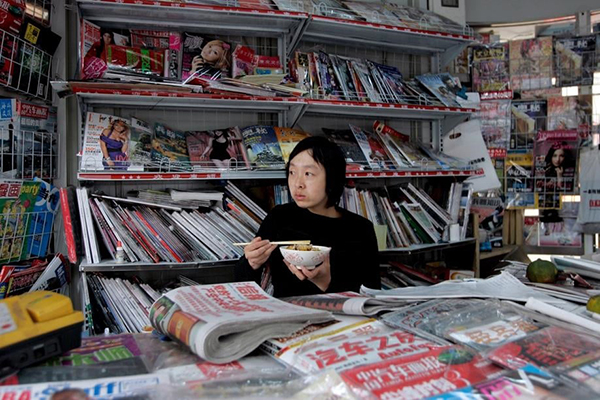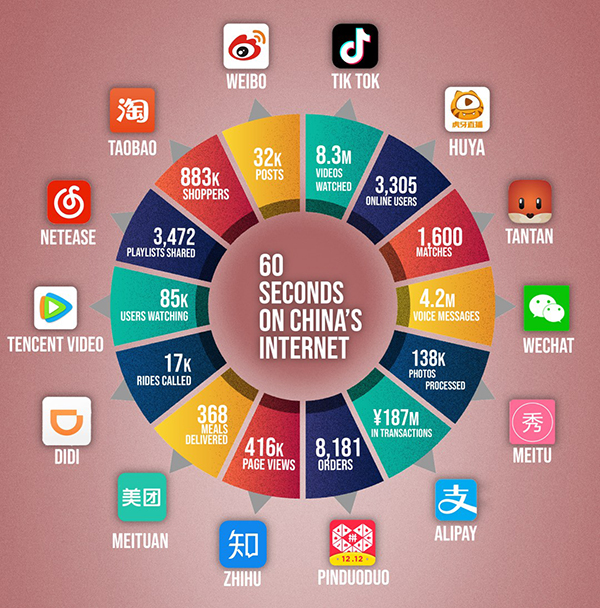China population is currently 1.4 billion. It is on the way to becoming one of the leading Superpowers. In 2013, China’s economic growth rate was 7.8%, almost three times higher than United States (2,8%).
China is a socialist, capitalist state ruled by a single-party – the Chinese Communist Party (CCP) – with Xi Jinping as their leader since 2012. In reality, China is much more orientated towards capitalism.
Development of Media
There were four phases in the development of the media in China.
• The first was the Founding of the new China in 1949 to 1966.
• The second was the Cultural Revolution from 1966 to 1978.
• The third involved a total change of the media system by Deng Xiaoping’s market reforms.
• The last phase began with the Tiananmen square uprising in 1989.
After the founding of the People’s Republic of China in 1949, the Communist party started to rule the country. General restrictions were placed on the media system. Private ownership of newspapers was abolished. General media became a party organ.
During the Cultural Revolution, media freedom suffered in the second phase. Anyone who had an opinion counter to Mao Zedong’s was considered as an enemy of the revolution. Television channels were reduced to five. 43 newspapers, which were published were controlled by the party itself. But printed media increased rapidly during 1957-1977 by 358%. Wired broadcasting, a system with speakers in rural China reached 99 million in 1980. It was mainly used for communicating with the rural population and to spread propaganda.
From 1978 to 1989 (third phase), under Deng Xiaoping’s rule there was a a media boom, especially in radio and later in television. In 1987, 55% of China’s population had access to television. Deng Xiaoping wanted to achieve economic independence by freedom of press.
From the Tiananmen uprising in 1989, when students demonstrated for more freedom, democracy and against governmental corruption, until today, there have been stricter restrictions of freedom of press and surveillance by the government. To circumvent this, people and organizations started to use their own distribution networks, like The Guangzhou Ribao, the daily newspaper in Guangzhou. This opened new markets for commercialization.
Television gained more popularity. Ownership of television increased many times. It became a status symbol and economic growth. But from 1980 to 1991, film audiences decreased by almost 50%.
When the Communist Party of China gained power, it created media outlets like the Xinhua News Agency, which became the mouthpiece of the government. Independent media is also regulated by the government.
China Media Today
There are still many restrictions on freedom of press.
Demographic. China has a literacy rate of 95%. The internet population is growing with about 600 million users. Over 90% of the internet population has a social network account and spends an average of 46 minutes a day on it. Most users of internet live in urban areas (72%). The number of mobile phones users hit 1.22 billion in 2013. One can say that in China new technologies are part of the daily life.
The majority of the people living in China are in the age between 25 and 54 (46.7%). The younger generation from 19 to 25 years account only for 19% of social media users in China. The Chinese use different social networks than in other parts of the world.
• Qzone (700 million users) is the ruling social network for blogging, sharing music and photos.
• Weibo (500 million users) is an alternative to Facebook and Twitter combined.
• WeChat (300 million users) is like WhatsApp.
Legal Regulations. Article 35 in China’s legal code is saying that “citizens of the People’s Republic of China enjoy freedom of speech, of the press of assembly, of association, of procession and of demonstration.” But in 1994, the propaganda department established the Six No’s, including:
• No private media ownership.
• No shareholding.
• No joint ventures with foreign organization.
• No discussion of nature of news/press law.
• No openness for foreign television.
Besides the No’s there is a “Chinese Newspaper Self-Discipline Agreement” what is saying that journalists must strictly follow all regulations and rules passed by the government. Further, discussions about passed laws and control of the CCP is forbidden.
Article 41 in China’s legal code says that Chinese citizens have the right to criticize the government, but Article 51 says the opposite: “Chinese people may not infringe upon the interest of the state.” The CCP’s central propaganda department ensures this.
Economic Influences. Economic development has had a big impact on the media development. In 1992 all newspapers were subsidized by the state. Today all newspapers and television stations, especially those not owned by the government, are mainly financed by advertisement. The media is increasingly focusing on business and entertainment and not anymore on reporting the latest news.
The Chinese government has difficulties in controlling the media. Hence, it censors the internet in many ways. Some Google and Facebook are totally censored and Wikipedia pages are put offline in times of major discussions in China. Instead, Qzone, Weibo and Wechat are the ruling social networks in China.
Netizens try to circumvent censorship by using proxy servers, to contact western media and banned social networks like Facebook. As many as 95 million Chinese could be on Facebook.
Talk Radio is known to be the freest media, where people anonymously discuss China’s problems. Talk Radios are very popular in China and the CCP is a little reserved into getting into conflict with its citizens.
Mass Media Infrastructure
China’s mass media has been growing since the 1980’s. Due to a range of technologies, it is more diversified, including wired systems, satellite, and the internet. With almost 2,000 newspapers, 9,000 magazines, 273 radio stations and 352 television stations they cover all kinds of different topics.
Xinhua News Agency, located in Beijing, is the primary and largest news agency. It is also considered as one of the world’s leading news agencies with 100 branches worldwide. By purchasing many other Asian news agencies in Japan, South Korea and Singapore it has achieved an influential status. China News Service also supplies news to Chinese living overseas.
Print Media. State run newspapers like the People’s Daily are more traditional and propagate the party’s interest. Other commercial newspapers showcase greater freedom with increasing diversity. All printed media is controlled by the CCP. Many follow Xinhua News Agency, which reflects official polices and promotes government propaganda.
Reference News (3.4 million daily and owned by Xinhua News Agency), People’s Daily (2.8 million) and Global Times (2 million) are the laregst newspapers. None of the major newspapers reflect any different point of view than CCP’s.
Local newspapers display a great variety and are more liberal orientated, even covering corruption among party workers.
Television and Radio. China has one large Radio station called China National Radio with 9 channels. Every province and region has its own local radio stations. China Radio International (CRI) is for the western world.
China Central Television (CCTV) is one large state-owned television network with 20 channels. It is state run and is a party organ of the CCP. It focusses more on news and traditional entertainment. Through its relationship with over 250 other television organizations in 130 countries it has a global impact. CCTV’s viewership is declining due to that fact that the younger generation prefers other outlets.
Other TV stations and several local and regional TV stations like Hunan TV Phonenix TV, Dragon TV and Travel TV display entertainment, documentaries and news. Almost every province has at least one satellite TV network.
Due to censorship all television channels including “independent” companies usually do not push the boundaries on news reporting.
Internet
2,000 out of 10,000 traditional newspapers are available on the internet. News pages like New York Times and BBC are censored.
• Qzone (712 million users) is targeted towards high school students and younger rural kids.
• Weibo is similar to Twitter, (500 million users)
• Gaming networks like 51.com has 259 million users.
Google is censored, and instead, Baidu is the dominant player in China’s search engine market (80% market share).
It is impossible to censor a post right away which leads to an easy exchange of information through networks like Weibo long before the official news.
Legal Framework
The “Chinese Newspaper Self-Discipline Agreement” says that journalists must strictly follow all regulation and rules passed by the government. Licensing for a newspaper business in China is very complicated.
Censorship. The Central Propaganda Department of the CCP is responsible for the media representing the party’s interest. It is common that reporters and editors censor themselves. People who report on secrets of the government or for example, revolution, have to face tough consequences and long terms in Chinese prisons.
Foreign journalists do censor themselves because they are worried about not getting a visa again. Many journalists do not know where the red line is, hence they must be even more careful.
The CPD has influence on every part of the media through the “50 cent” army.
On social networks like Weibo, the CPD allows government criticism but silences collective expression. It is all done by keyword filtering, a 20,000 to 50,000 internet police and the “50 cent” army.
Western/American Influence
Western way of life or the American way of life has a huge impact in China. An increasing number of people prefer to watch “idol style” shows instead of the state owned television stations which show more documentaries and news. The CPD wants to cut back on American-style television like singing competitions by restricting the timings, despite being popular.
The authorities do not like the populist and western input that the shows promote. In addition, the voting system in singing competitions promote a democratic way of thinking. All of this could than lead to problems for the Chinese government.
Conclusion
The Internet and new forms of media are more open and diverse. The majority of Chinese people do not really mind censorship because they perceive their culture as something unique. China’s internet environment is led by Weibo, Tencent, Baidu and many other small organizations. Rural television medium plays a significant part in conveying information to the Chinese people.
The Chinese legal framework is very controversial and it gives the CCP complete control over media freedom. In China all the media is controlled by the CPD. The Central Propaganda Department is using hard power approach for limiting media freedom in China. Reporters including foreign journalists are censoring themselves worried about the results if they write the whole truth.
As regards internet and social networks, the CPD focuses more on preventing collective actions than just individual critical posts about the government. The impact of Western and American style of media is not welcomed by Chinese authorities because they are worried about western inputs that could potentially lead to loss of power.
China’s Malicious Use of Social Media
China uses a variety of methods to spread its narrative abroad through social media, including:
Government-controlled media: China has a large state-run media apparatus that includes major news outlets such as Xinhua and CCTV, which are used to disseminate official government views and information to a global audience.
Social media platforms: China has a large presence on global social media platforms such as Twitter, Facebook, and YouTube, where it uses official and unofficial accounts to disseminate information and engage with foreign audiences.
Influencers and opinion leaders: China uses a network of influencers and opinion leaders, including scholars, business leaders, and celebrities, to promote its views and interests abroad.
Fake news and disinformation: China has been accused of spreading false information and disinformation through social media platforms in order to influence public opinion and shape global perceptions of China.
Censorship and control: China censors and controls the information that is available on social media within its own borders and also the information that is disseminated abroad to control the narrative about China.
Cyber-espionage: China has been known to use cyber-espionage techniques to hack into foreign social media accounts and steal information that can be used to spread disinformation or to silence critics
Artificial intelligence and automation: China is also known to use AI and automation to amplify its voices on social media and to spread disinformation at scale.
China’s approach to social media is often seen as an attempt to shape global perceptions of China and to advance its own interests and agenda.



















